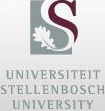In 2019, Stellenbosch University's (SU) Central Analytical Facilities – which provides advanced scientific testing, analytical instrumentation, and research expertise – commissioned a dedicated research Positron Emission Tomography and Computed Tomography (PET-CT) unit. From the outset, it was evident that this new facility should work closely with the neighbouring Tygerberg Hospital PET-CT unit, known as the Western Cape Academic PET-CT Centre (WCAPC).
A PET-CT scanner is a sophisticated imaging tool that uses radioactive tracers to provide detailed anatomical and functional insights into diseases. It enables clinicians and researchers to visualise biological processes such as inflammation, tissue oxygenation, and cancer progression.
“At the time, there was a strong demand from SU's clinical researchers to use PET-CT for studying various forms of tuberculosis and treatment responses," said Professor Alex Doruyter, director of the research unit, which is now known as the NuMeRI Node for Infection Imaging (NII). “We saw the potential for a dedicated research unit to meet this need."
The timing aligned perfectly with a call by the Department of Science and Innovation (DSI) for proposals to fund national research infrastructure projects under the South African Research Infrastructure Roadmap (SARIR). One of the approved initiatives was the Nuclear Medicine Research Infrastructure (NuMeRI) project, and SU's successful bid led to the establishment of the NII as a node of this national platform.
“The major advantage of PET-CT is that it is non-invasive," Doruyter explained. “It allows researchers to study diseases in living patients without the need for biopsies or surgery. This has great clinical value – from diagnosing and grading disease severity to formulating treatment plans and monitoring response – and also opens up significant research opportunities."
Despite generous funding from the DSI, establishing a PET-CT facility remains a costly endeavour, requiring specialised personnel with scarce skills. SU Faculty of Medicine and Health Sciences (FMHS) provided co-funding and developed a model in which the NII could operate in parallel with the WCAPC. “This arrangement enabled cost savings for both facilities," said Doruyter.
Today, the NII and WCAPC operate independently but collaborate closely. “We provide mutual support whenever possible," Doruyter said. “Our radiographers, radiopharmacists, and nuclear physicians contribute reciprocally to each other's operations when capacity allows. This adds resilience to both units."
The facilities also share key equipment, which would be prohibitively expensive to duplicate. Additionally, their physical proximity enables better management of radioactive consumables, which decay over time. “Radioactive doses have a short half-life, so waste can be substantial," Doruyter noted. “Having two facilities next to each other allows us to reduce this waste and improve efficiency."
From the outset, a Joint Interface Management Committee—comprising representatives from both the university and the hospital—was established to oversee and manage the collaboration. According to Doruyter, the partnership has received strong support from the Western Cape Department of Health. “They've seen the value of having us nearby. For example, when the Tygerberg scanner was out of service, we stepped in to scan multiple public sector patients. This avoided significant financial losses in wasted radiopharmaceuticals and ensured patients didn't miss critical therapies."
The benefits have been mutual. “A few years ago, when Tygerberg Hospital was without a radiopharmacist for some time, our university radiopharmacist provided radiolabelled doses for the province. This ensured continuity of care for public patients who otherwise would not have received their scans," he said.
In addition to its clinical and research functions, the NII plays a vital role in training the next generation of specialists. The unit offers hands-on training opportunities for postgraduate students in radiopharmacy, as well as nuclear medicine. “Because of the high-end equipment and the collaborative environment, students are exposed to real-world challenges and scans acquired with advanced imaging techniques that prepare them for leadership roles in both academic and clinical settings," Doruyter noted.
Doruyter emphasised that the collaboration reflects the longstanding, trusted relationship between SU and its provincial partners. “This partnership has been built over many years, and we are committed to preserving and expanding it – including broadening access to more radiopharmaceuticals in future."

